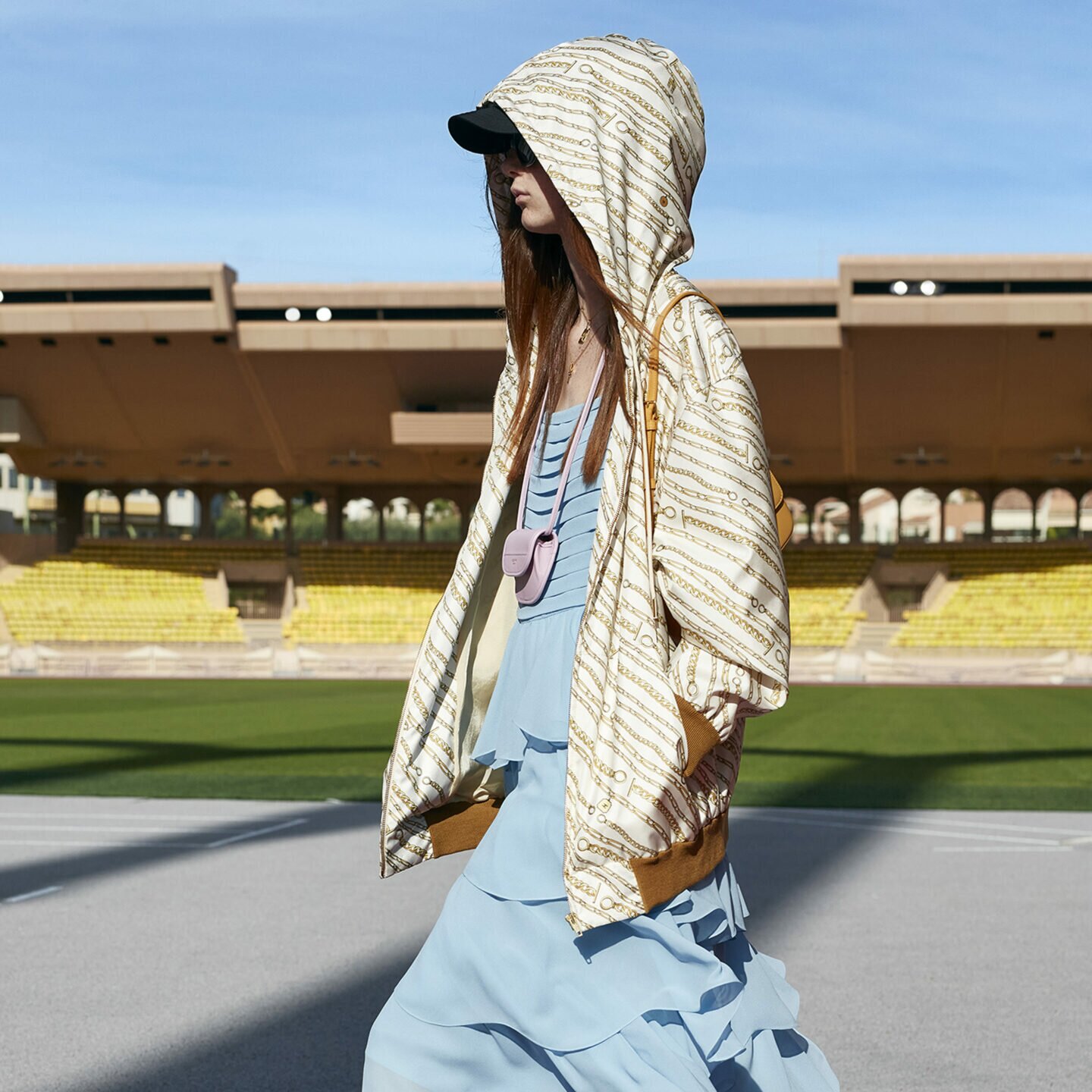Fashion designers, much like nearly everyone else, spent most of last year WFH for their SS21 collections. As borders started shutting and the world went into lockdown, they were faced with a seemingly impossible task: to dream up clothes we’d want to wear in a future devoid of travelling and mingling.
No surprises, then, the slouchy silhouette became de rigueur. Leading the way was Raf Simons’ first collaboration with Miuccia Prada, which she described as an attempt “to create something that makes sense to people, something that is useful. Everything we do should allow people to live better”.
Logo tunic tops with matching slim-cut pants channelled the comfiness of pyjamas but oozed an impeccable sharpness. Models, clad in turtleneck knits and pencil skirts, clung to their slouchy trench and cocoon coats. The look was timeless, the effect ladylike.
At Louis Vuitton, creative director Nicolas Ghesquière took the slouchy silhouette further, turning the spotlight on “non-binary people, who are taking a lot of freedom dressing themselves as they want and, in turn, giving a lot of freedom to all of us”.
Baggy, pleated chino pants were worn with a white sweatshirt (that screamed “vote”). Roomy, floor-length coats were thrown over boxy T-dresses. Jackets could be tightened or loosened for the desired fit. All these were accompanied by sensible footwear too, from mannish leather lace-ups to chunky-heeled pumps borrowed from Minnie Mouse. Ghesquière added: “I found it inspiring to explore what the items are that represent this wardrobe that is not feminine, not masculine.”
With “unisex, uni-size, uni-everything” as the theme, meanwhile, Demna Gvasalia reckoned we’d be donning Balenciaga for a long time. “Ten years from now, everything in fashion will be sustainable… I think we will be reusing the clothes we have… So, I thought: In 2030, how will your favourite things look, aged and destroyed?”
His collection proffered long-sleeved parka-meets-prairie maxi dresses, languid gowns in silver sequins or crushed satin edged with lace, fuzzy bathrobe coats, baggy tracksuits and faux fur bedroom slippers. The best bit: “According to who wears it, the silhouette changes, but whoever wears it, it looks good,” Gvasalia proclaimed.
Over at Bottega Veneta, Daniel Lee demonstrated “how you can feel done up and elegant at the same time as feeling comfortable” with winning and super-wearable combos of knitted tanks and wide-legged pants. Rounding up the throw-it-on contingent were Loewe, Celine, Christian Dior, Valentino and Hermès with unstructured statement coats, billowing shirtdresses, baggy pants and relaxed suiting.
Historical shifts in the way women dressed have long been tied to feminine and feminist ideals, so what does our love affair with comfort dressing say about women empowerment? Lots, apparently.
During the late 1800s, roomy tunics and bloomers allowed the ladies to participate in outdoor activities with much more ease than if they’d been wearing long dresses. In the 1920s, flappers opted for oversized, fluid dresses and bobbed hair in rebellion against the restrictive corsets, bustle skirts and elaborate hairdos that preceded. In the 1940s, as more women joined the workforce, mannish shirts and wide-legged trousers or jeans (a la Katherine Hepburn) became popular.
The miniskirts, shift dresses and chunky-heeled boots of the 1960s made a strong counterpoint to the demure, wasp-waisted ’50s housewife frocks. In the late ’70s, Diane Keaton’s Annie Hall wore baggy men’s style shirts, tweed blazers and pants, in contrast to the disco divas in their slinky wrap dresses and halterneck jumpsuits, and as a precursor to the wide-fitting power suit of the 1980s.
Indeed, the oversized cut, with its implications for women empowerment, has been repeated, recycled and repurposed throughout the 20th century. In recent times, it often doubled as a statement about the confines of gender identity, propelled by celebs the likes of Janelle Monae, Sam Smith and Elliot Page speaking out on #IAmNonBinary. The online movement has inspired many to articulate their wish to identify as, look like or behave as male or female, or anywhere in between.
And it looks to become the preferred silhouette for now and beyond. When Covid-19 hit the world in 2020, and while grappling with the new norm, we sought solace in our capsule wardrobes of sweatpants, yoga tights and pyjamas. Suddenly — and finally — we had epiphanies about how oppressive fashion had been thus far. We jettisoned underwired bras, killer heels, anything too stiff and those unforgiving bodycon party dresses that forced us to suck in our tummies (or struggle into shapewear), as we battled the self-loathing from impulse shopping and overflowing landfills.
When we had nowhere to hang, and were concerned about self-care, mental wellness and financial security like never before, we stopped buying stuff we no longer needed, because we no longer had to impress people we don’t know or like. Now, as we genuinely began dressing for ourselves, we discovered that comfort is key!
And designers have responded to this zeitgeist with clothes made for body-positive homebodies. We Netflix and chill, raise plant babies, feed sourdough starters, do online workouts in the living room and curl up with Kindle in between Zoom work meetings. The only time a jacket is required? Maybe over our tracksuit when popping out for a brisk walk or grocery run.
Sweatpants were once likened to “a sign of defeat”, but for real women with real lives and real struggles, we can certainly do with some slack. Like actor Elliot Page — he came out as transgender in December 2020 — who was once snapped in sweatpants by the paparazzi.
“And the writer asked, ‘Why does [this] petite beauty insist upon dressing like a massive man?’ Because I like to be comfortable… There are pervasive stereotypes about masculinity and femininity that define how we’re all supposed to act, dress and speak. And they serve no one.”
